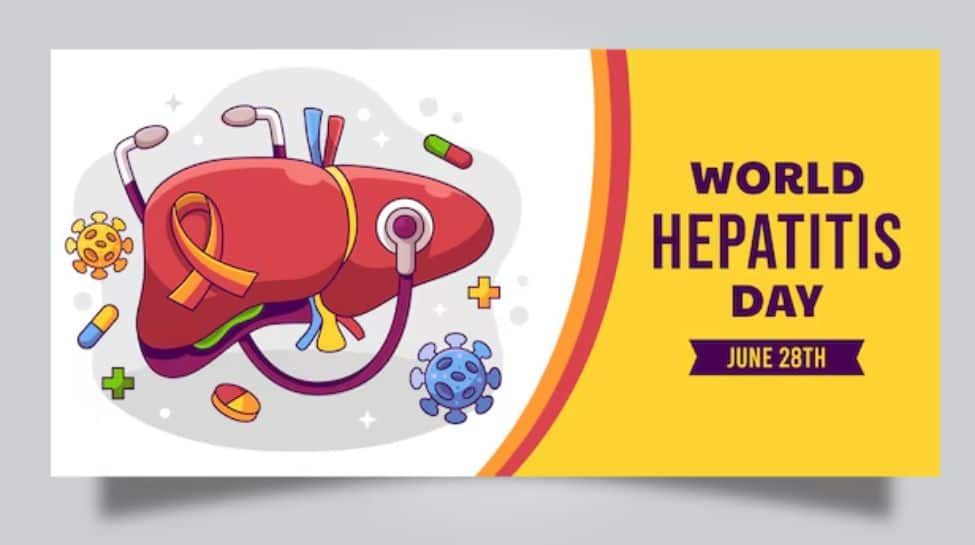World Hepatitis Day, observed on July 28, aims to raise global awareness about hepatitis—a significant health concern affecting millions worldwide. Hepatitis is an inflammation of the liver caused by viral infections, toxic substances, autoimmune diseases, and other factors. The most common types—hepatitis A, B, C, D, and E—pose varying levels of risk and health complications, particularly hepatitis B and C, which can lead to chronic liver disease and liver cancer.
Globally, over 354 million people live with chronic hepatitis B and C, contributing to significant mortality and morbidity.
In India, hepatitis is a major public health issue. According to the World Health Organization (WHO), approximately 40 million people in India are chronically infected with hepatitis B, making it one of the countries with the highest burdens of this disease worldwide. Hepatitis C affects an estimated 6 to 12 million Indians. The National Viral Hepatitis Control Program (NVHCP) aims to combat this public health crisis by promoting awareness, prevention, and treatment efforts shared by Charu Dua, Chief Clinical Nutritionist, Amrita Hospital Faridabad.
Understanding Hepatitis
Hepatitis is classified into five main types, each with unique transmission modes and health impacts:
• Hepatitis A and E: Typically cause acute hepatitis, transmitted through contaminated food or water.
• Hepatitis B and C: Can lead to chronic infections, transmitted through body fluids, unsafe injection practices, and from mother to child during birth.
• Hepatitis D: Occurs only in those already infected with hepatitis B, worsening the severity of infection.
Causes and Lifestyle Habits Increasing Hepatitis Risk
Several lifestyle habits significantly increase the risk of contracting hepatitis:
1. Unprotected Sexual Activity
• Risk: Engaging in unprotected sex is a primary transmission route for hepatitis B and C.
• Solutions:
Use Protection: Always use condoms to reduce the risk of transmission.
Get Vaccinated: Vaccination against hepatitis B is crucial.
Regular Testing: Regular STI testing for those with multiple or new partners.
Education: Educate about risks and preventive measures.
2. Intravenous Drug Use
• Risk: Sharing needles or other drug paraphernalia significantly increases the risk of hepatitis B and C.
• Solutions:
Needle Exchange Programs: Access sterile needles through exchange programs.
Supervised Injection Sites: Use supervised sites if available.
Addiction Treatment: Seek treatment to reduce or eliminate drug use.
Safe Practices: Never share needles or syringes.
3. Poor Sanitation and Hygiene
• Risk: Hepatitis A and E are spread through contaminated food or water.
• Solutions:
Clean Water: Ensure access to clean drinking water; use filters or boil water if necessary.
Hygiene Practices: Wash hands thoroughly with soap and water.
Food Safety: Avoid raw or undercooked foods and ensure sanitary food preparation.
Vaccination: Get vaccinated against hepatitis A.
4. Unsafe Medical Practices
• Risk: Unsafe medical practices, including the reuse of needles, facilitate hepatitis B and C spread.
• Solutions:
Healthcare Standards: Ensure medical facilities adhere to sterilization protocols.
Personal Advocacy: Advocate for safe practices and verify sterile equipment.
Blood Safety: Ensure blood transfusions are screened and safe.
Training and Resources: Support training for healthcare workers in low-resource settings.
5. Body Piercing and Tattooing
• Risk: Unsterilized equipment used in body modification procedures can spread hepatitis B and C.
• Solutions:
Licensed Professionals: Use licensed professionals following strict hygiene practices, Karela government has made it mandatory to for tattoo artist to have license to practise. Other states should also adopt the same .
Sterilization Verification: Ensure equipment is sterilized before use.
Aftercare: Follow recommended aftercare to prevent infections.
Public Awareness: Raise awareness about the risks of unsterile practices.
6. Alcohol Consumption
• Risk: Excessive alcohol intake can cause liver damage, making the liver more vulnerable to hepatitis infections.
• Solutions:
Moderate Drinking: Limit alcohol consumption to moderate levels.
Avoid Binge Drinking: Avoid heavy drinking episodes.
Seek Help: For those struggling with alcohol use, seek support from healthcare providers or support groups.
7. Sedentary Lifestyle
• Risk: Lack of physical activity contributes to obesity and Metabolic Associated Fatty Liver Disease (MAFLD), which can exacerbate liver problems and increase susceptibility to hepatitis.
• Solutions:
Regular Exercise: Engage in regular physical activity.
Healthy Weight: Maintain a healthy weight through diet and exercise.
Consult Professionals: Seek advice from healthcare providers for personalized fitness plans.
8. Unhealthy Diet
• Risk: Poor diet can lead to obesity, diabetes, and MAFLD, increasing the risk of liver diseases including hepatitis.
• Solutions:
Balanced Diet:
i. Fruits and Vegetables: Aim for at least five servings a day. They are rich in essential vitamins, minerals, and antioxidants that help combat oxidative stress on the liver.
ii. Whole Grains: Include whole grains like brown rice, oats, and whole wheat bread, which provide fiber and nutrients essential for overall health.
iii. Lean Proteins: Choose lean proteins such as poultry, fish, beans, and legumes. Protein is vital for repairing liver cells and maintaining muscle mass.
iv. Healthy Fats: Include sources of healthy fats like avocados, nuts, seeds, and mustard oil, olive oil. These fats can reduce inflammation and support heart health. Avoid high fatty meals and trans fats.
Limit and control Sugar intake: Avoid sugary snacks, sugary drinks and beverages, and choose whole fruits over fruit juices.
Avoid Processed Foods: Limit intake of processed foods, packaged food, instant foods which are often high in unhealthy fats, sugars, and sodium. These can contribute to liver inflammation and other health issues
Limit Salt Intake: High sodium intake can lead to fluid retention and worsen conditions like ascites (abdominal swelling). Opt for low-sodium options and use herbs and spices to flavour food.
Hydration: Stay hydrated by drinking plenty of water throughout the day. Proper hydration supports liver function and helps flush out toxins from the body.
Avoid Alcohol: Alcohol can exacerbate liver damage and is particularly harmful to individuals with hepatitis. Complete abstinence from alcohol is recommended.
Complications of Hepatitis
Chronic hepatitis B and C can lead to severe health problems, including:
• Chronic liver disease
• Cirrhosis
• Liver cancer
• Liver failure: Complications include bleeding disorders, ascites, portal hypertension, kidney failure, hepatic encephalopathy, and hepatocellular carcinoma.
Prevention and Treatment
Prevention
Vaccination
• Effective vaccines are available for hepatitis A and B.
• Vaccination for hepatitis B also prevents hepatitis D.
Safe Practices
• Hygiene: Regular handwashing and safe food and water consumption.
• Medical Procedures: Use sterile equipment and ensure safe practices in medical settings.
• Safe Sex: Use protection to prevent transmission through sexual contact.
Treatment
• Hepatitis B: Antiviral medications manage chronic infections. A vaccine is available for prevention.
• Hepatitis C: Antiviral medications can cure over 95% of infections. No vaccine available.
• Hepatitis A and E: Generally self-resolving, but supportive care is essential.
• Autoimmune Hepatitis: Managed with corticosteroids and immunosuppressive medications.
• Toxic Hepatitis: Involves stopping exposure to the toxin and managing liver damage.
Why Awareness is needed?
Awareness is crucial because many people with hepatitis are asymptomatic and remain undiagnosed until they develop severe liver disease. Early detection through screening can significantly improve treatment outcomes and prevent the spread of the virus. Awareness campaigns help to educate the public about transmission risks, preventive measures, and the availability of vaccination and treatment options.
In conclusion, World Hepatitis Day underscores the importance of awareness, prevention, and treatment in the fight against hepatitis. Lifestyle choices and behaviours significantly influence the transmission and prevention of this disease. By understanding and addressing the risk factors associated with hepatitis, individuals and communities can take proactive steps to protect themselves and reduce its global burden. Public health initiatives, education, and access to medical interventions are key components in the effort to eliminate hepatitis, aiming for a future free of this potentially deadly disease. Through informed actions, practical solutions, and a healthy diet, we can make significant strides toward reducing hepatitis as a public health threat.
By adopting safer lifestyle habits and supporting public health initiatives, we can significantly reduce the global burden of hepatitis and improve health outcomes for millions. In India, comprehensive efforts like the National Viral Hepatitis Control Program are crucial to combating this public health crisis through awareness, vaccination, and treatment. World Hepatitis Day highlights the need for global awareness and action to combat hepatitis, emphasizing the collective responsibility to achieve a hepatitis-free future.















































